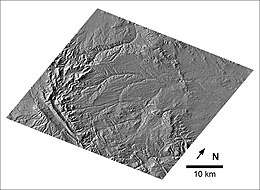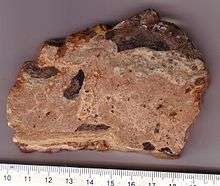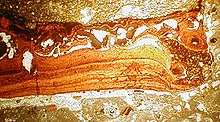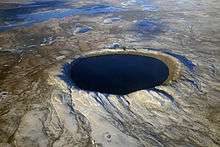Azuara impact structure
The Azuara impact structure is a structural feature of about 30 kilometres (19 mi) diameter,[1] located in northeastern Spain, roughly 50 kilometres (31 mi) south of Zaragoza.[2] The name is attributed to the small town of Azuara located near the center of the structure. The first hint to a possible impact origin was given by Wolfgang Hammann as early as 1980, and the first field evidence was provided by Johannes Fiebag in the early eighties. In 1985, Ernstson et al.[3] published the occurrence of shock metamorphism, and Azuara was established (Grieve & Shoemaker 1994, Hodge 1994, Norton 2002 [4][5][6] as an authentic impact structure. From stratigraphic considerations and paleontological dating, its age is estimated to be Upper Eocene or Oligocene (roughly 30 - 40 Mill. years old).
 Morphological signature of the Azuara structure taken from the digital map of Spain, 1:250,000 | |
| Impact crater/structure | |
|---|---|
| Confidence | Probable[1] |
| Diameter | ~30 km (19 mi) |
| Age | 32 to 40 Ma Late Eocene or Early Oligocene |
| Exposed | Yes |
| Drilled | No |
| Location | |
| Coordinates | 41.18°N 0.88°W[1] |
| Country | Spain |
| State | Aragon |
| Province | Zaragoza Province |
| Municipality | Azuara |
 Location of the crater in Spain | |



The Azuara structure exhibits a roughly circular morphology implying a partly pronounced outer ring. The inner part is covered by post-impact Upper Cenozoic sediments, however in the outer rim zone, the outcrop conditions are excellent.
Impact features
The impact nature is documented by abundant polymictic and monomictic breccias, breccia dikes, extensive megabreccias and impact ejecta, dislocated megablocks, geophysical anomalies and shock metamorphism. Shock effects like melt glass, diaplectic glass, planar deformation features (PDFs) are found in breccias and breccia dikes, and PDFs are abundant also in quartzite clasts contributing to the ejecta (Pelarda Formation).[3][7][8][9]
Shock metamorphism in the Azuara impact structure include planar deformation features in quartz. The histogram displays frequencies of crystallographically controlled planes of microdeformation. The {1013} and {1012} occurrences are especially diagnostic and are generally considered as in proof of impact shock.[10]
Controversy
Like many other impact structures in the world, such as Nördlinger Ries, the Vredefort crater, or the Sudbury Basin, the origin of the Azuara structure has been debated, and Spanish geologists still remain opposed to an impact origin. [11] In their opinion the shock effects are tectonic features, the impact ejecta (Pelarda Formation) are Quaternary alluvial fans and impact breccias and dike breccias are interpreted as karst features and soil formations.
The opposition against the impact origin for Azuara has been supported by an analysis and paper (Langenhorst & Deutsch 1996)[12][13] denying the occurrence of shock metamorphism in Azuara rocks. Based on this paper and analysis, Azuara was removed from the Canadian Impact Data Base when its management changed to the University of New Brunswick. Azuara is still listed as a confirmed impact structure in other data bases, e.g. Moilanen, J., 2009 and the Expert Database on Earth Impact Structures (EDEIS).[14]
Companion impact structures
Since 1994 it has been hypothesized that Azuara is only part of a much larger multiple impact event (Azuara impact event), comprising also an elongated impact basin suggested to have resulted from the impact of a string of impactors. This Rubielos de la Cérida basin bears all evidence of impact features like morphological signature, polymictic and monomictic breccias, megabreccias, ejecta deposits, shock metamorphism, suevites and impact melt rocks.[9][15][16]
References
- Mikheeva, 2017
- Azuara
- Ernstson K., Hammann W., Fiebag J. and Graup G. (1985) Evidence of an impact origin for the Azuara structure (Spain). Earth and Planetary Science Letters 74:361-370
- Grieve R. A. F. and Shoemaker E. M. (1994) The record of past impacts on Earth. In Hazards Due to Comets and Asteroids, edited by T. Gehrels. Space Science Series Tucson, Arizona, USA: Univ. Arizona Press. pp. 417-462
- Hodge P. (1994) Meteorite craters and impact structures of the Earth. Cambridge, UK: Cambridge University Press. 124 p.
- "Norton, O.R. (2002) The Cambridge Encyclopedia of Meteorites"
- Ernstson K. and Claudin F. (1990) Pelarda Formation (Eastern Iberian Chains, NE Spain): Ejecta of the Azuara impact structure. N. Jb. Geol. Paläont. Mh.:581-599.
- Ernstson K. and Fiebag J. (1992) The Azuara impact structure (Spain): new insights from geophysical and geological investigations. Int. J. Earth Sci. (Geol. Rundschau) 81(2):403-427
- Ernstson, K., Claudin, F., Schüssler, U. & Hradil, K. (2002): The mid-Tertiary Azuara and Rubielos de la Cérida paired impact structures (Spain). - Treb. Mus. Geol. Barcelona, 11, 5 - 65.
- Stöffler, D. & Langenhorst, F. (1994). Shock metamorphism of quartz in nature and experiment: I. Basic observation and theory. Meteoritics. 29: 155-181.
- Cortés A. L., Diaz-Martínez E., Sanz-Rubio E., Martínez-Frías J. and Fernández C. (2002) "Cosmic impact versus terrestrial origin of the Azuara structure (Spain): A review." Meteoritics & Planetary Science 37: 875-894.
- Langenhorst F. and Deutsch A. (1996)"The Azuara and Rubielos structures, Spain: Twin impact craters or Alpine thrust systems?"
- TEM investigations on deformed quartz disprove shock origin" (abstract). Lunar and Planetary Science XXVII.
- EDEIS Expert Database on Earth Impact Structures Archived July 27, 2011, at the Wayback Machine
- Ernstson, K., Claudin, F., Schüssler, U., Anguita, F. and Ernstson, T. 2001. Impact melt rocks, shock metamorphism, and structural features in the Rubielos de la Cérida structure, Spain: evidence for a companion to the Azuara impact structure, in: Impact markers in the stratigraphic record, 6th ESF-IMPACT workshop Granada, abstract book: 23-24.
- Ernstson, K., Rampino, M. R., and Hiltl, M. (2001) Cratered cobbles in Triassic Buntsandstein conglomerates in northeastern Spain: An indicator of shock deformation in the vicinity of large impacts. Geology, 29: 11-14.
Bibliography
- Mikheeva, Anna. 2017. The Complete Catalog of the Earth's Impact structures, 1. Russian Academy of Sciences. Accessed 2019-04-02.

